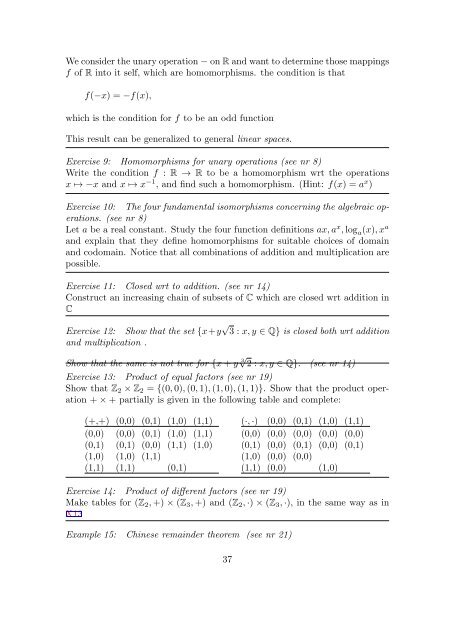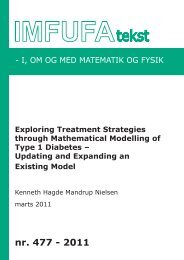ABSTRACT ALGEBRAIC STRUCTURES OPERATIONS AND ...
ABSTRACT ALGEBRAIC STRUCTURES OPERATIONS AND ...
ABSTRACT ALGEBRAIC STRUCTURES OPERATIONS AND ...
Create successful ePaper yourself
Turn your PDF publications into a flip-book with our unique Google optimized e-Paper software.
We consider the unary operation − on R and want to determine those mappings<br />
f of R into it self, which are homomorphisms. the condition is that<br />
f(−x) = −f(x),<br />
which is the condition for f to be an odd function<br />
This result can be generalized to general linear spaces.<br />
Exercise 9: Homomorphisms for unary operations (see nr 8)<br />
Write the condition f : R → R to be a homomorphism wrt the operations<br />
x ↦→ −x and x ↦→ x −1 , and find such a homomorphism. (Hint: f(x) = a x )<br />
Exercise 10: The four fundamental isomorphisms concerning the algebraic operations.<br />
(see nr 8)<br />
Let a be a real constant. Study the four function definitions ax, a x , log a(x), x a<br />
and explain that they define homomorphisms for suitable choices of domain<br />
and codomain. Notice that all combinations of addition and multiplication are<br />
possible.<br />
Exercise 11: Closed wrt to addition. (see nr 14)<br />
Construct an increasing chain of subsets of C which are closed wrt addition in<br />
C<br />
Exercise 12: Show that the set {x+y √ 3 : x, y ∈ Q} is closed both wrt addition<br />
and multiplication .<br />
Show that the same is not true for {x + y 3√ 2 : x, y ∈ Q}. (see nr 14)<br />
Exercise 13: Product of equal factors (see nr 19)<br />
Show that Z2 × Z2 = {(0, 0), (0, 1), (1, 0), (1, 1)}. Show that the product operation<br />
+ × + partially is given in the following table and complete:<br />
(+,+) (0,0) (0,1) (1,0) (1,1)<br />
(0,0) (0,0) (0,1) (1,0) (1,1)<br />
(0,1) (0,1) (0,0) (1,1) (1,0)<br />
(1,0) (1,0) (1,1)<br />
(1,1) (1,1) (0,1)<br />
(·, ·) (0,0) (0,1) (1,0) (1,1)<br />
(0,0) (0,0) (0,0) (0,0) (0,0)<br />
(0,1) (0,0) (0,1) (0,0) (0,1)<br />
(1,0) (0,0) (0,0)<br />
(1,1) (0,0) (1,0)<br />
Exercise 14: Product of different factors (see nr 19)<br />
Make tables for (Z2, +) × (Z3, +) and (Z2, ·) × (Z3, ·), in the same way as in<br />
X13<br />
Example 15: Chinese remainder theorem (see nr 21)<br />
37
















